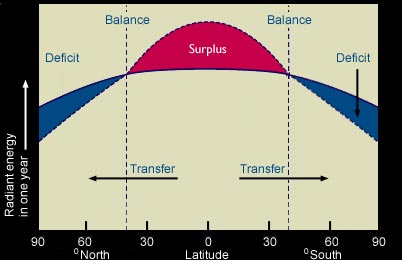Atmosphere Contents
3. Energy Variation
A redistribution of the Earth's energy is continually occurring
The amount of energy received at different latitudes varies substantially. The equator receives 2.5 times as much energy as the poles. However, there is no build up of heat at the equator. On a global scale the Earth is in thermal equilibrium: that is, it must be losing as much heat as it is receiving. It might at first be thought that each region would be in thermal equilibrium with itself: those regions gaining the most heat, losing the most. However, this is not so. Only at around 37º north and south is there a balance. Equator-ward there is a surplus and polewards a deficit and yet the equator is not heating up and the poles are not cooling. A redistribution of the Earth's heat must be continually occurring: heat is being lost by the tropics and transported to the poles. This transport takes place within the oceans and atmosphere by means of the general circulation of both the atmosphere and the oceans. The transfer of heat varies according to latitude and season. The intensity of the poleward flow is linked to the meridional (north-south) temperature gradient which is greatest in winter, so transport and air circulation are at a maximum then. To understand these transfers within the atmosphere it is necessary to consider the general circulation of the atmosphere.

How much more energy is received by the equator than by the poles?